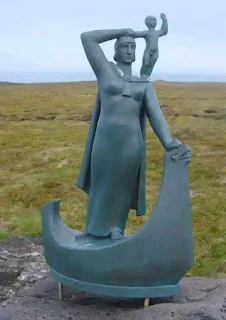DISCOVERY: The Exploration Of Gudrid "Far Traveler"
By Victor Olubiye
Around 1,000 A.D., long before Christopher Columbus arrived in the Americas, a young Icelandic explorer named Gudrid Thorbjarnardottir, known as the “Far Traveler,” embarked on a remarkable journey across the Atlantic. Gudrid’s story is one of courage, resilience, and exploration, as she not only settled in new lands but also gave birth to a son, Snorri, who is believed to be the first European child born in North America. Her adventures are chronicled in two Viking sagas, The Saga of the Greenlanders and The Saga of Erik the Red. While these sagas include fantastical elements like ghosts and dragons, they also contain historically significant details that have been corroborated by archaeological discoveries.
Gudrid’s life was intertwined with the Viking exploration of the North Atlantic. She was part of an expedition led by Thorfinn Karlsefni, which aimed to establish a permanent settlement in a place the Norse called Vinland, believed to be part of modern-day Newfoundland. This journey was part of a broader wave of Viking exploration that extended from Scandinavia to Greenland and eventually to the edges of North America. Gudrid’s role in these expeditions highlights the active participation of women in Viking society, not just as settlers but as key figures in exploration and colonization.
Archaeological evidence has lent credibility to Gudrid’s story. In 1975, a spindle whorl—a tool used for spinning wool—was discovered at L’Anse aux Meadows, a Norse settlement in Newfoundland. This artifact is significant because it suggests the presence of Viking women at the site, as spinning was traditionally women’s work. The settlement itself, dating to around 1,000 A.D., aligns with the timeline of Gudrid’s journey, providing tangible proof of Norse presence in North America centuries before Columbus.
Further evidence emerged in 2001, when archaeologists uncovered an ancient longhouse in Iceland’s Skagafjordur valley, a location described in the sagas as Gudrid’s final home. The structure was unusual for its time in Iceland, bearing a striking resemblance to the turf houses found at L’Anse aux Meadows. This architectural similarity suggests a direct connection between the two sites and supports the idea that Gudrid and her companions brought building techniques from North America back to Iceland. The discovery of this longhouse not only ties Gudrid’s story to a specific location but also underscores the cultural exchange that occurred as a result of Viking exploration.











Comments